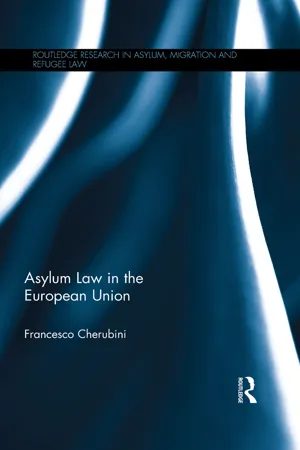
- 290 pages
- English
- ePUB (mobile friendly)
- Available on iOS & Android
Asylum Law in the European Union
About this book
This book examines the rules governing the right to asylum in the European Union. Drawing on the 1951 United Nations Convention relating to the Status of Refugees, and the 1967 Protocol, Francesco Cherubini asks how asylum obligations under international refugee law have been incorporated into the European Union.
The book draws from international law, EU law and the case law of the European Court of Human Rights, and focuses on the prohibition of refoulement; the main obligation the EU law must confront. Cherubini explores the dual nature of this principle, examining both the obligation to provide a fair procedure that determines the conditions of risk in the country of origin or destination, and the obligation to respond to a possible expulsion.
Through this study the book sheds light on EU competence in asylum when regarding the different positions of Member States. The book will be of great use and interest to researchers and students of asylum and immigration law, EU law, and public international law.
Frequently asked questions
- Essential is ideal for learners and professionals who enjoy exploring a wide range of subjects. Access the Essential Library with 800,000+ trusted titles and best-sellers across business, personal growth, and the humanities. Includes unlimited reading time and Standard Read Aloud voice.
- Complete: Perfect for advanced learners and researchers needing full, unrestricted access. Unlock 1.4M+ books across hundreds of subjects, including academic and specialized titles. The Complete Plan also includes advanced features like Premium Read Aloud and Research Assistant.
Please note we cannot support devices running on iOS 13 and Android 7 or earlier. Learn more about using the app.
Information
1 The Geneva Convention of 1951 and its Protocol of 1967
1.1 Definition of refugee
As a result of events occurring before 1 January 1951 and owing to well-founded fear of being persecuted for reasons of race, religion, nationality, membership of a particular social group or political opinion, is outside the country of his nationality and is unable or, owing to such fear, is unwilling to avail himself of the protection of that country; or who, not having a nationality and being outside the country of his former habitual residence as a result of such events, is unable or, owing to such fear, is unwilling to return to it.33 Article 1A also contains a clause (1) giving a definition of ‘history’ or ‘statutory’ refugees: see A. Grahl-Madsen (1966–1972, II: 108 ff.) and, more recently, S. Schmahl (2011a: 247 ff.).
Table of contents
- Cover
- Half Title Page
- Series Page
- Title Page
- Copyright Page
- Dedication Page
- Table of Contents
- Acknowledgements
- Introduction
- 1 The Geneva Convention of 1951 and its Protocol of 1967
- 2 The 1950 Rome Convention and its Protocols
- 3 Evolution of EC and EU competences for asylum
- 4 International protection in EU legislation
- Conclusions
- Bibliography
- Index